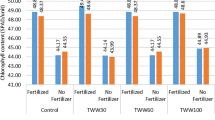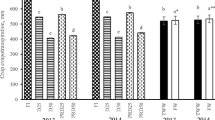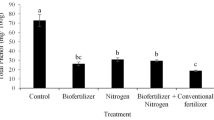Abstract
Mulberry fruits have greater potential of dietary fiber, vitamins, minerals and carbohydrates. It should be free from heavy metals which are dangerous for human health. Therefore, current study was carried out to limit the use of wastewater impact on mulberry plants and also evaluate permissible wastewater limits for better plant growth and development. Different soil nutrients were maximum in 40 wastewater irrigations (T7). The significantly higher plant height increment and leaf area was recorded from 16 wastewater irrigations and 24 tubewell irrigations (T4). The highest fresh and dry leaf weights and Leaf nitrate content were calculated from 16 wastewater irrigations and 24 tubewell irrigations (T4). The significantly higher leaf ash was recorded from 24 wastewater irrigations and 16 tubewell irrigations (T5). Leaf chlorophyll content was significantly higher recorded from 24 wastewater irrigations and 16 tubewell irrigations (T5). Leaf iron content was significantly greater from 16 wastewater irrigations and 24 tubewell irrigations (T4). Leaf zinc and cadmium contents were significantly higher from 16 wastewater irrigations and 24 tubewell irrigations (T4) and 12 wastewater irrigations and 28 tubewell water irrigations (T3). Leaf copper content was significantly greater from 12 wastewater irrigations and 28 tubewell water irrigations (T3) and leaf lead content was significantly greater from 32 waste water irrigations and 8 tubewell irrigations (T6). Plant height increment has significant correlation with all studied traits except total leaf chlorophyll content, leaf proline content and leaf lead content.
Similar content being viewed by others
References
Ahmad R, Anjum MA, Malik W (2019) Genetic diversity and selection of suitable molecular markers for Zizyphus germplasm. Erwerbs-Obstbau 61:345–353
Alikhasi M, Kouchakzadeh M, Baniana E (2012) The effect of treated municipal wastewater irrigation in non-agricultural soil on cotton plant. J Agric Sci Technol 14:1357–1364
Anjum MA, Rauf A, Bashir MA, Ahmad R (2018) The evaluation of biodiversity in some indigenous Indian jujube (Zizyphus mauritiana) germplasm through physico-chemical analysis. Acta Sci Polo Hort Cult 17(4):39–52
Arora M, Kiran B, Rani S, Rani A, Kaur B, Mittal N (2008) Heavy metal accumulation in vegetables irrigated with water from different sources. Food Chem 111:811–815
Bedouh Y, Bekhouche F (2012) Influence of treated wastewater irrigation on some biochemical parameters of onion (Allium cepa). Ann Biol Res 3:4820–4827
Castro E, Mañas MP, Heras DLJ (2009) Nitrate content of lettuce (Lactuca sativa L.) after fertilization with sewage sludge and irrigation with treated wastewater. Food Addit Contam A Chem Anal Control Expo Risk Assess 26:172–179
Costa M, Beltrao J, De-Barito JC, Neves MA, Guerrero C (2010) The sludge and manure effects on the growth of citrus trees. WSEAS Trans Environ Dev 6:721–730
Delouee SA, Urooj A (2007) Antioxidant properties of various solvent extracts of mulberry (Morus indica L.) leaves. Food Chem 102:1233–1240
Gecgel U, Velioglu SD, Velioglu HM (2011) Investigating some physicochemical properties and fatty acid composition of native black mulberry (Morus nigra L.) seed oil. J Am Oil Chem Soc 88:1179–1187
Golchin L, Zehtab S, Shafagh J (2013) Effects of irrigation times and wastewater concentration of a leaven producing factory (Iran Mayeh) on some morphological characters of alfalfa. Int J Agric Crop Sci 5(23):2831–2836
Hina S, Iftikhar T, Ramzan S (2013) Comparison of proximate and heavy metal contents of vegetables grown with fresh and wastewater. Pak J Bot 45(2):391–400
Hseu ZY (2004) Evaluating heavy metal contents in nine composts using four digestion methods. Bioresour Technol 95(1):53–59
Huang G (2013) Would use of contaminated water for irrigation lead to more accumulation of nitrate in crops? Environ Pollut 2:1–9
Jaya DS (2009) Assessment of heavy metal contamination in the evergreen tree Mangifera indica L. and soils near National Highway-47 in Thiruvananthapuram District, Kerala. Toxicol Int 16:43–47
Jury WA, Vaux HJ (2007) The emerging global water crisis: managing scarcity and conflict between water users. Adv Agron 95:1–76
Karandish F (2012in) Use of Wastewater in Agriculture. In: The 1th International and the 4th National Congress on Recycling of Organic Waste in Agriculture Isfahan, 26–27 April 2012
Kouser S, Samie A (2009) Wastewater use in cauliflower production and farmer’s health: an economic analysis. Pak Dev Rev 1:47–66
Morgan KT, Wheaton TA, Parsons LR, Castle WS (2008) Effects of reclaimed municipal waste water on horticultural characteristics, fruit quality, and soil and leaf mineral concentration of citrus. HortScience 43(2):459–464
Muhammad H, Ayub M, Iqbal Z, Malik MA (2013) Heavy metals toxicity in Psidium guajava irrigated by polluted water of Hudiara drain in district Lahore, Punjab Pakistan. Biologia 59(2):239–244
Murtaza G, Ghafoor A, Qadir M, Owens G, Aziz MA, Zia MH (2010) Disposal and use of sewage on agricultural lands in Pakistan: a review. Pedosphere 20(1):23–34
Mushtaq N, Khan S (2010) Heavy metals contamination of soils in response to wastewater irrigation in Rawalpindi Region. Pak J Agric Sci 47(3):215–224
Nafees M, Hussain R, Ahmad I, Ahsan M, Aslam MN, Ahmad M, Manzoor A (2019) Role of foliar application of salicylic acid and cultivars in Chilli (Capsicum frutescens L.) production in arid region of Bahawalpur. J Hort Sci Technol 2(1):5–9
Naz S, Anjum MA, Haider STA (2019) Effect of different irrigation sources on growth, yield and heavy metals accumulation in tomato and okra. J Hort Sci Technol 2(1):10–19
Noori M, Mahdye M, Norozi R (2014) Effects of municipal wastewater irrigation on physiological and phytochemical parameters of Aegilops columnaris Zhuk. Int J Res Agric Food Sci 1:1–9
Oregoni KE, Pazira E, Najafi P, Moezi AA (2012) Effects of treated low quality wastewater on growth parameters of Young Zard Olive (Olea. europaea L.) cultivar in different irrigation conditions. Adv Environ Biol 6(7):2158–2163
Parsons LR, Wheaton TA, Castle WS (2001) High application rates of reclaimed water benefit citrus tree growth and fruit production. HortScience 36:1273–1277
Qadir M, Wichelns D, Raschid-Sally L, McCornick PG, Drechsel P, Bahri A, Minhas PS (2010) The challenges of wastewater irrigation in developing countries. Agric Water Manag 97:561–568
Rehman K, Ashraf S, Rashid U, Ibrahim M, Hina S, Iftikhar T, Ramzan S (2013) Comparison of proximate and heavy metal contents of vegetables grown with fresh and wastewater. Pak J Bot 45:391–400
Singh A, Agrawal M (2010) Effects of municipal waste water irrigation on availability of heavy metals and morpho-physiological characteristics of Beta vulgaris L. J Environ Biol 31:727–736
Tabari M, Salehi A, Mohammadir J (2011) Impact of municipal waste water on growth and nutrition of afforested Pinus eldarica stands. In: Einschlag FSG (ed) Wastewater Evaluation and Management
Acknowledgements
The authors are highly grateful to the Bahauddin Zakariya University, Multan for financial support to conduct the study.
Author information
Authors and Affiliations
Corresponding author
Ethics declarations
Conflict of interest
A.S. Gul,F. Naveed, M. Ali, R. Ahmad and M. Saqib declare that they have no competing interests.
Rights and permissions
About this article
Cite this article
Gul, A.S., Naveed, F., Ali, M. et al. Effect of Different Wastewater Irrigation Regimes on Growth of Mulberry (Morus macroura Miq.). Erwerbs-Obstbau 63, 331–337 (2021). https://doi.org/10.1007/s10341-021-00577-3
Received:
Accepted:
Published:
Issue Date:
DOI: https://doi.org/10.1007/s10341-021-00577-3




